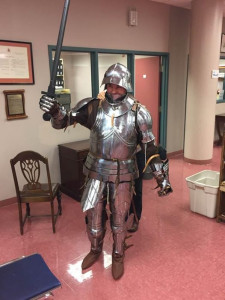Become a Practicing Historian with Dr. Scott Moir
 When it comes to bringing lessons to life in the classroom, CBU professor Dr. Scott Moir is known campus-wide as the perfect role-model. Each time we ask students to shout out their favourite professors, Dr. Moir’s name plasters our feed, with students crediting his interactive teaching style for making their university experience top-notch.
When it comes to bringing lessons to life in the classroom, CBU professor Dr. Scott Moir is known campus-wide as the perfect role-model. Each time we ask students to shout out their favourite professors, Dr. Moir’s name plasters our feed, with students crediting his interactive teaching style for making their university experience top-notch.
Dr. Moir began teaching history at CBU in 2002, after graduating from the University of Guelph. As a child, Dr. Moir adopted his love of history from his father, who was constantly soaking in knowledge on the subject and eagerly welcomed discussions. “Our family vacations were always connected to historical events,” says Dr. Moir. “And he loved to take us to places where important things had happened.” Because of this, Dr. Moir learned to make connections to the historical world at a very young age, and his love of history has continued to blossom ever since.
Throughout his own education, Dr. Moir was lucky to find mentorship under fantastic and influential professors whose teaching methods inspired the development of his own. “My professors always trusted me to go out and try things on my own, while pushing me out of my comfort zone,” says Dr. Moir. “They rewarded me for going out on a limb and treated me as an equal, which is something I try to do for my students as well.”
Students in Dr. Moir’s classes are exposed to everything from the early medieval world to the modern-day, including a look at how money and economics have shaped the world we live in, for those lucky enough to check out his “History of Money” course.
Dr. Moir focuses on the skills of research, analysis, critical thinking and writing which history students can apply to numerous aspects of their lives. “I remind my students that they are already historians,” says Dr. Moir. “Everything they are interested in has its own history and they’ve almost surely already sought out and engaged with that history on their own.” His method simply teaches students new ways of examining history as a way to understand and interact with the world around them.
Instead of exclusively leading lectures with Powerpoint slides, Dr. Moir helps his students explore original materials and sources with their own hands. Sitting for a boring exam? Not in Dr. Moir’s class; you’ll find yourself attempting to decode 17th-century handwriting or analyzing the records of a witch trial. Students try on medieval gear and feel the weight of a knight’s sword in their hand as they engage with the subject matter on another level.
“The classroom should be a collaboration between the professor and the students,” says Dr. Moir. “I want to be able to give students tools and experiences that connect to their own interests, helping them to become researchers and historians in their own right.”
As Dr. Moir explains, there has been a dramatic increase in calls for the study of history and historical literacy recently. Those who study history are presented with new perspectives on circumstances that have occurred throughout humanity, preparing them to understand the complexity of the issues facing the world today. “Being a history nerd is fun,” says Dr. Moir. “But it also helps you engage as a citizen and find solutions to the problems we are currently facing. I encourage my students to be practicing historians no matter where they go.”
Dr. Moir says he is lucky and proud to work in a department with faculty like Dean of the School of Arts & Social Sciences, Dr. Andy Parnaby, Assistant Professor of History, Dr. Lachlan MacKinnon and Professor Emeritus and Viola Desmond Chair of Social Justice, Dr. Graham Reynolds who continue to inspire him with their teaching excellence and community engagement. He praises CBU’s partnerships with the Beaton Institute, the Art Gallery, the Fortress of Louisbourg and Parks Canada for providing our students with experiential and hands-on opportunities to engage with history here in Cape Breton.
Want to learn more about studying history at CBU? Check out the program page here.